Book contents
- Frontmatter
- Contents
- List of figures
- List of tables
- Notes on contributors
- Preface
- The club framework
- Part I Club emergence
- Part II Club sponsorship and club design
- Part III Club design and effectiveness
- 9 The impact of sponsorship on club standards and design
- 10 The emergence and design of NGO clubs in Africa
- 11 The benefits of accreditation clubs for fundraising nonprofits
- Future research and conclusions
- Index
- References
11 - The benefits of accreditation clubs for fundraising nonprofits
from Part III - Club design and effectiveness
Published online by Cambridge University Press: 10 November 2010
- Frontmatter
- Contents
- List of figures
- List of tables
- Notes on contributors
- Preface
- The club framework
- Part I Club emergence
- Part II Club sponsorship and club design
- Part III Club design and effectiveness
- 9 The impact of sponsorship on club standards and design
- 10 The emergence and design of NGO clubs in Africa
- 11 The benefits of accreditation clubs for fundraising nonprofits
- Future research and conclusions
- Index
- References
Summary
How can fundraising organizations signal trustworthiness to prospective donors? One way to do this is by conforming to standards of excellence and allowing a trusted, independent agency to monitor the organization with regard to these standards. The Central Bureau of Fundraising (CBF) in the Netherlands is an example of a club running such an accountability program. This chapter empirically investigates whether (1) awareness of the accountability program among donors increases donations by households; and (2) fundraising organizations that participate in the accountability program attract more donations than organizations that do not. To help understand the context in which the program operates, I will first briefly describe the regulation of fundraising in the Netherlands.
In contrast to the US context of many of the chapters in this volume, in the Netherlands the regulation of nonprofits can be described as a combination of few legal requirements, little government involvement, some self-regulation, and independent monitoring by a third party. The focus of the regulation that does exist is on fundraising practices. Nonprofit organizations that want to claim tax-exemption status have to register with the tax authorities, but are not required to submit audited financial statements or elaborate reports to obtain the status. To raise money in a door-to-door collection or in town, a permit from the municipality in which the collection is planned is required. Door-to-door collection is still a very common method of raising funds in the Netherlands. Such fundraising is done by unpaid volunteers for large, national fundraising organizations.
- Type
- Chapter
- Information
- Voluntary Regulation of NGOs and NonprofitsAn Accountability Club Framework, pp. 253 - 280Publisher: Cambridge University PressPrint publication year: 2010
References
- 11
- Cited by



